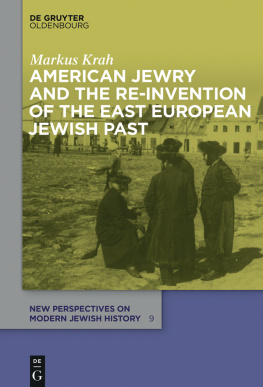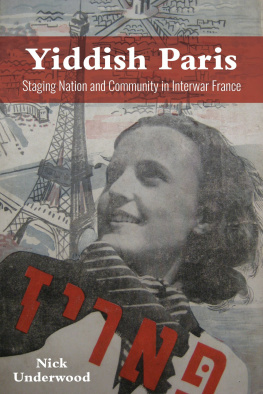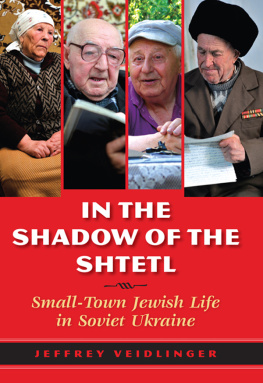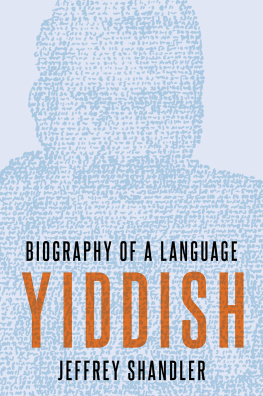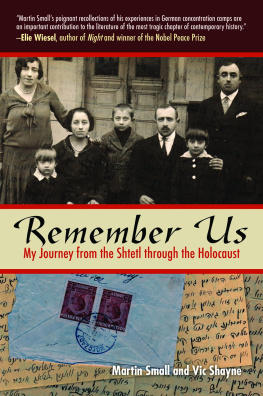
THE SHTETL: IMAGE AND REALITY
The European Humanities Research Centre
UNIVERSITY OF OXFORD
The European Humanities Research Centre of the University of Oxford organizes a range of academic activities, including conferences and workshops, and publishes scholarly works under its own imprint, LEGENDA. Within Oxford, the EHRC bridges, at the research level, the main humanities faculties: Modern Languages, English, Modern History, Literae Humaniores, Music and Theology. The Centre stimulates interdisciplinary research collaboration throughout these subject areas and provides an Oxford base for advanced researchers in the humanities.
The Centre's publications programme focuses on making available the results of advanced research in medieval and modern languages and related interdisciplinary areas. An Editorial Board, whose members are drawn from across the British university system, covers the principal European languages. Titles include works on French, German, Italian, Portuguese, Russian and Spanish literature. In addition, the EHRC co-publishes with the Society for French Studies, the British Comparative Literature Association and the Modern Humanities Research Association. The Centre also publishes Oxford German Studies and Film Studies, and has launched a Special Lecture Series under the LEGENDA imprint.
Enquiries about the Centre's publishing activities should be addressed to:
Professor Malcolm Bowie, Director
Further information:
Kareni Bannister, Senior Publications Officer
European Humanities Research Centre
University of Oxford
47 Wellington Square, Oxford OX1 2JF
enquines@ehrc.ox.ac.uk
www.ehrc.ox.ac.uk
Legenda
STUDIES IN YIDDISH
Editorial Committee
Professor Malcolm Bowie (General Editor)
All Souls College
Professor Marion Aptroot
Heinrich Heine University, Dsseldorf
Dr Gennady Estraikh
Oxford Institute for Yiddish Studies
Dr Mikhail Krutikov
Oxford Institute for Yiddish Studies
Professor David Roskies
Jewish Theological Seminary of America, New York
Professor Joseph Sherman
University of the Witwatersrand, Johannesburg
Volume Editor
Professor Ritchie Robertson, St John's College
Senior Publications Officer
Mrs Kareni Bannister
LEGENDA
EUROPEAN HUMANITIES RESEARCH CENTRE STUDIES IN YIDDISH 2
The Shtetl: Image and Reality
Papers of the Second Mendel Friedman International Conference on Yiddish
Edited by
Gennady Estraikh and Mikhail Krutikov
First published 2000
Published by the European Humanities Research Centre of the University of Oxford 47 Wellington Square Oxford OX1 2JF
LEGENDA is the publications imprint of the European Humanities Research Centre
Published 2017 by Routledge
2 Park Square, Milton Park, Abingdon, Oxon OX14 4RN
711 Third Avenue, New York, NY 10017, USA
Routledge is an imprint of the Taylor & Francis Group, an informa business
European Humanities Research Centre of the University of Oxford 2000
ISBN 13: 978-1-900755-41-2 (pbk)
All rights reserved. No part of this publication may be reproduced or disseminated or transmitted in any form or by any means, electronic, mechanical, photocopying, recording or otherwise, or stored in any retrieval system, or otherwise used in any manner whatsoever without the express permission of the copyright owner
British Library Cataloguing in Publication Data
A CIP catalogue record for this book is available from the British Library
LEGENDA series designed by Cox Design Partnership, Witney, Oxon
Dafna Clifford is a Research Fellow at the Oxford Institute for Yiddish Studies and the School of Oriental and African Studies, London.
Gennady Estraikh is Lecturer in Yiddish Linguistics at the Oxford Institute for Yiddish Studies and the School of Oriental and African Studies, London.
Hillel Kazovsky is a Ph.D. student at the Hebrew University, Jerusalem.
Moss Kijak is a Professor at Belgrano University, Buenos Aires.
John D. Klier is Corob Professor of Modern History at University College London.
Mikhail Krutikov is Lecturer in Modern Yiddish Literature at the Oxford Institute for Yiddish Studies and the School of Oriental and African Studies, London.
David G. Roskies is Professor of Jewish Literature at the Jewish Theological Seminary of America, New York.
Alia Sokolova is a Research Fellow at the St Petersburg Jewish University.
Anna Shternshis is a D.Phil, student at the University of Oxford.
The Yiddish word goles (Diaspora) usually occurs in an idiom or context with a meaning of suffering or oppression. Patient waiting for the Messiah, who would bring salvation from exile, and the quest for a do-it-yourself liberation (e.g. Zionism or Communism), often had only one thing in commonrejection of the goles life as a norm. Accordingly, Yiddish was widely despised, or even hated, being seen as an alien 'jargon' imposed on Jews during their centuries-long slavery. None the less, from the end of the nineteenth century the 'jargon' of East European Jewry acquired influential supporters, Yiddishists, whoalbeit divided by huge ideological gulfswere instrumental in improving dramatically the status of Yiddish. Still, even Yiddishists, many of whom envisaged the East European Jewish habitat as the sole place where an egalitarian, Jew-friendly society could eventually be built, were not about to carry into their future the existing form of the goles the shtetl. It was a City of the Sun or a Communist Pastoral rather than a Shtetl of the Sun which fascinated the psyche of the Jewish radical. True, in the late 1920s and in the 1930s there was a movement in Poland, called Landkentenish (the study of local lore, history and economies), which looked sympathetically at the shtetl. However, this movement remains merely a footnote in modern Jewish history.
Although the word 'shtetl', a calque from the corresponding Slavic words (e.g. Polish miasteczko ) , means 'little town', it became a byword for a populous civilization, dispersed all over Eastern Europe, but at the same time connected via ubiquitous religious, business, cultural and family networks. From the end of the nineteenth century, modernization, migration, emigration and revolutions ate away at the Jewish shtetl. Shtetl life mostly perished in the ashes of the Second World War, though many of its landmarks and a few people have survived until now, notably in Ukraine and Belorussia.
It is illuminating to note that the shtetl does not play a prominent part in the history of the Gentile population of Eastern Europe, apparently because the non-Jewish cohorts of the 'little town' dwellers did not differ significantly from their Gentile counterparts living in villages or (proper) towns. The Jewish shtetl, on the other hand, was a world apart. Even so, it is a distorted picture of the shtetl which completely excludes its non-Jewish residents, or reduces them to extras (e.g. shabes-goyim, Gentile helpers for the Sabbath chores) in an all-Jewish saga: in reality, Gentiles very often made up the majority of the shtetl population. There are many examples of such a misrepresentation. Thus, The New International Webster's Dictionary of the English Language (1995 edition) defines the shtetl as a 'small Jewish town or village in Eastern Europe during the 19th and 20th century until World War IP. The New Oxford Dictionary of English (1998 edition) fortunately omits this misleading chronology (as if the shtetl did not exist prior to the nineteenth century), but echoes the notion that the shtetl is 'a small Jewish town or village in eastern Europe', adding that the word 'shtetl' came into English from Yiddish in the 1940s.



